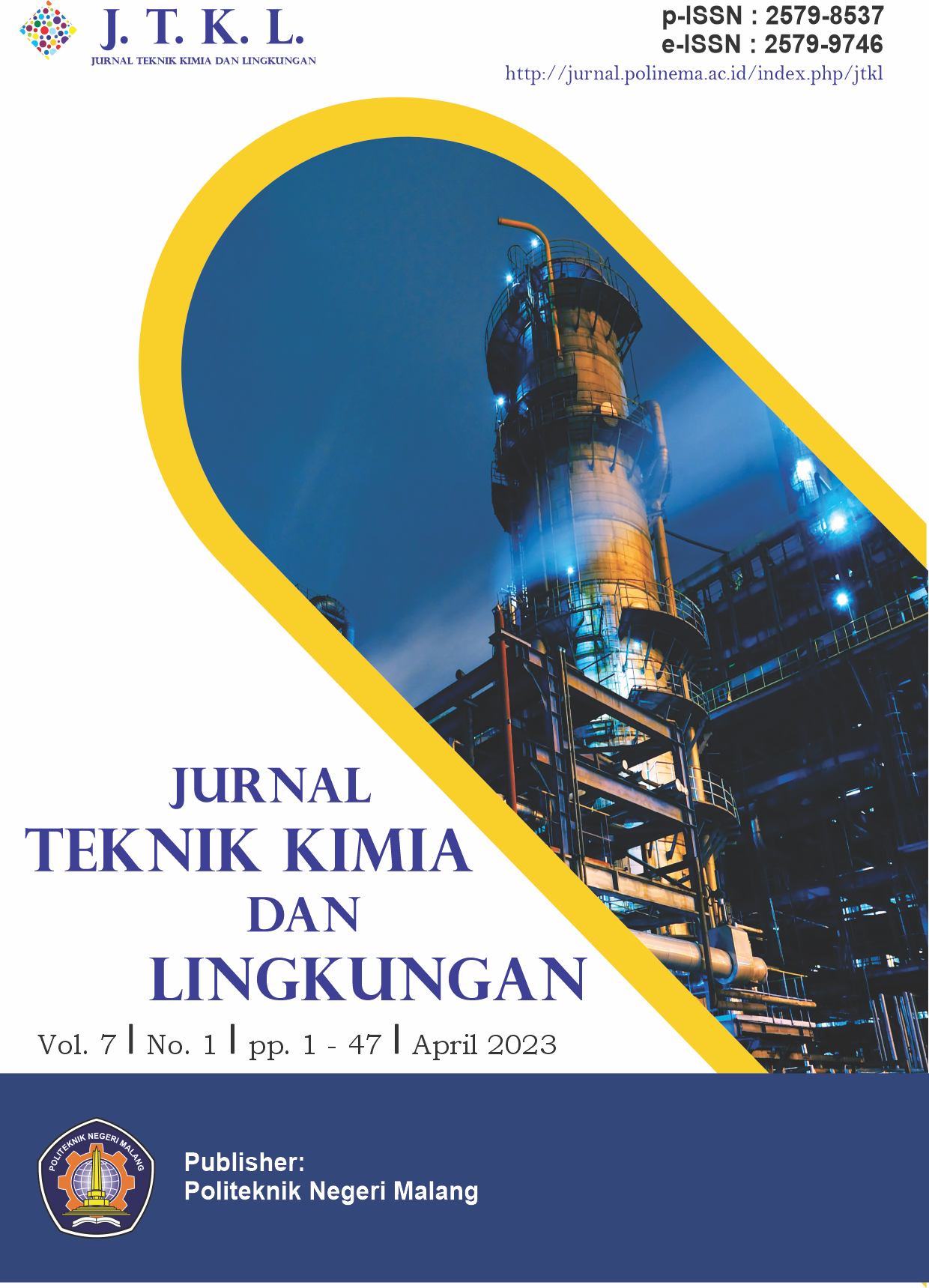Valorization of Waste Cooking Oil into Liquid Organic Fertilizer by Anaerobic Fermentation Method
DOI:
https://doi.org/10.33795/jtkl.v7i1.356Keywords:
EM4 activator, fermentation, liquid organic fertilizer, waste cooking oil.Abstract
Liquid organic fertilizer is a type of fertilizer that has a liquid form with a brownish color and is commonly used in agriculture as a supporting material for the main fertilizer. Liquid organic fertilizer can be produced through the fermentation process of organic matter, such as plant residues, animal or human waste, and organic waste so that it will not damage the environment. The manufacture of liquid organic fertilizer in this study uses waste cooking oil as raw material which will be fermented anaerobically for 21 days with the use of EM4 activator volume of 10 mL and 50 mL. This study was conducted to determine how much potential used cooking oil waste can be converted into liquid organic fertilizer. The results showed that the best concentration of nitrogen, phosphorus, potassium, and carbon organic in liquid organic fertilizer was obtained at 10 mL volume of EM4 activator. The best nitrogen concentration is 0.520 ppm, the best phosphorus concentration is 12.213 ppm, the best potassium concentration is 12013.825 ppm, and the best organic carbon concentration is 2.10%.
References
M. Febrianna, S. Prijono, N. Kusumarini, Pemanfaatan Pupuk Organik Cair untuk Meningkatkan Serapan Nitrogen serta Pertumbuhan dan Produksi Sawi (Brassica juncea L.) pada Tanah Berpasir, Jurnal Tanah dan Sumberdaya Lahan, vol. 5, no. 2, pp. 1009-1018, 2018.
A. Rasmito, A. Hutomo, A. P. Hartono, Pembuatan Pupuk Organik Cair dengan Cara Fermentasi Limbah Cair Tahu, Starter Filtrat Kulit Pisang dan Kubis, dan Bioaktivator EM4, Jurnal IPTEK, vol. 23, no. 1, pp. 55-62, 2019.
N. M. Witariadi, B. R. T. Putri, Teknologi Fermentasi untuk Meningkatkan Kualitas Pupuk Organoplus, Buletin Udanaya Mengabdi, vol. 17, no. 3, pp. 93-98, 2018.
M. A. Akib, H. Setiawati, Fermentation of Whey Waste as Organic Liquid Fertilizer “PUCAFU”, Agrotech Journal, vol. 2, no. 2, pp. 7-13, 2017.
Elfidiah, K. A. Roni, Liquid Waste Palm Oil Plantations as Liquid Fertilizer. Journal of Computational and Theoretical Nanoscience, vol. 16, no. 12, pp. 5166-5170, 2019.
A. D. Ardiyanti, L. Adhitama, R. Wahyutiyani, Efficient Compost Fertilizer with Addition of Fatty Acid Results of Used Cooking Oil Saponification Reaction, Proc. Internat. Conf. Sci. Engin, vol.3, pp. 125-128, 2020.
N. Tanti, Nurjannah, R. Kalla, Pembuatan Pupuk Organik Cair dengan Cara Aerob, ILTEK, vol. 14, no. 2, pp. 2053-2058, 2019.
I. G. A. Kasmawan, G. N. Sutapa, I. M. Yuliara, Pembuatan Pupuk Organik Cair Menggunakan Teknologi Komposting Sederhana, Buletin Udayana Mengabdi, vol. 17, no. 2, pp. 67-72, 2018.
H. Yua, B. Xie, R. Khan, G. Shen, The Changes in Carbon, Nitrogen Components and Humic Substances During Organic-Inorganic Aerobic Co-Composting, Journal Bioresource Technology, vol. 271, pp. 228-235, 2019.
A. H. I. Nurrahma, M. Melati, Pengaruh Jenis Pupuk dan Dekomposer terhadap Pertumbuhan dan Produksi Padi Organik, Bul. Agrohorti, vol. 1, no. 1, pp. 149-155, 2013.
M. Makiyah, Analisis Kadar N, P, dan K pada Pupuk Cair Limbah Tahu dengan Penambahan Tanaman Matahari Meksiko (Thitonia diversivolia), Under Graduates Thesis, Universitas Negeri Semarang, 2013.
Sulfianti, Risman, I. Saputri, Analisis NPK Pupuk Organik Cair dari Berbagai Jenis Air Cucian Beras dengan Metode Fermentasi yang Berbeda, Jurnal Agrotech, vol.11, no.1, pp. 36-42, 2021.
R. Syafri, Chairil, D. Simamora, Analisa Unsur Hara Makro Pupuk Organik Cair (POC) dari Limbah Industri Keripik Nenas dan Nangka Desa Kualu Nenas dengan Penambahan Urin Sapi dan EM4, Photon: Jurnal Sain Dan Kesehatan, vol. 8, no. 1, pp. 99-104, 2017.
P. K. Atmodjo, Optimalisasi Gula Cair dan pH Medium untuk Fermentasi Alkohol dari Jus Curucuma xanthorihiza, Biota, vol. 2, no. 3, pp. 97-104, 2017.
S. Rosniawaty, R. Sudirja, M. Ariyanti, S. Mubarok, A. Wahyudin, Pengaruh Bahan Organik terhadap Kesuburan Tanah serta Pertumbuhan dan Fisiologi Tanaman Kakao Muda Hasil Transplanting di Tanah Inceptisol, Jurnal Kultivasi, vol. 20, no. 3, pp. 160-167, 2021.
Downloads
Published
Issue
Section
License
Copyright (c) 2023 Budi Santoso, Arista Putri Permatasari, Sisilia Pratama, Prahady Susmanto, R.R. Yunita Bayu Ningsih

This work is licensed under a Creative Commons Attribution-NonCommercial 4.0 International License.







